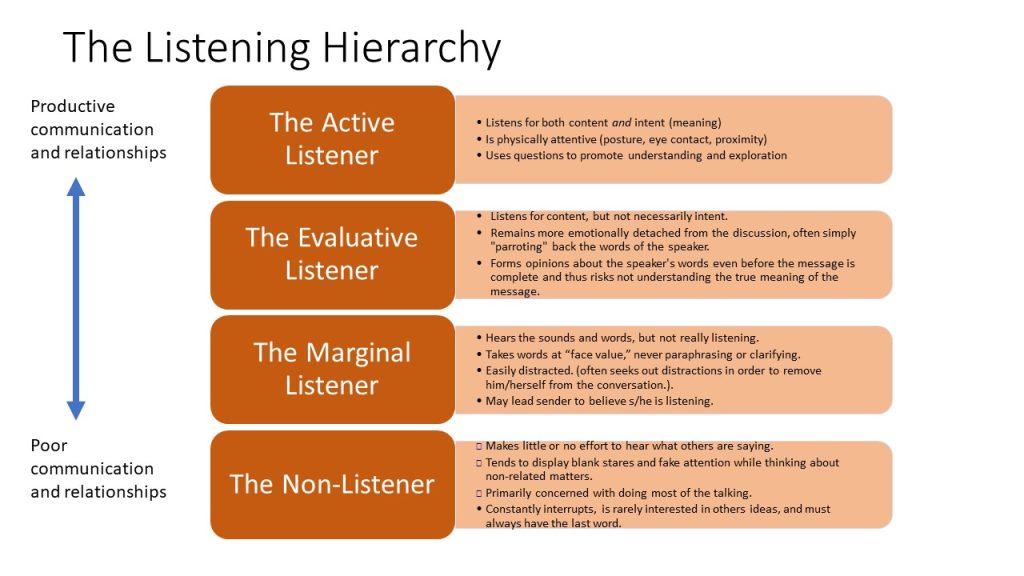Active Listening

Barriers to Listening
Typically, we only really listen to 10% of what we hear.
- Because we’re not interested
- Because we’re distracted
- Because we don’t like the speaker
- Because we believe the other cannot be influenced
- Because we view the subject matter as irrelevant
- Because we don’t understand the language or the subject
- Because we don’t want to put in the effort
- Because we’re preoccupied with something else
- Because of our prejudices
- Because of our lack of confidence, or our fear
Ten Commandments of good listening
- STOP TALKING – You cannot listen while you are talking. Polonius said: “Give every man thine ear, but few thy voice”.
- PUT THE SPEAKER AT EASE – Help him or her feel that he or she is free to talk.
- SHOW THAT YOU WANT TO LISTEN – Look and act interested. Don’t ignore her while she talks. Listen to understand…rather than to reply.
- REMOVE DISTRACTIONS – Don’t doodle, tap your foot, or shuffle papers.
- EMPATHIZE WITH HIM – Try to put yourself in his shoes so you can see his point of view.
- BE PATIENT – Allow plenty of time. Don’t interrupt her. Don’t start for the door or walk away.
- HOLD YOUR TEMPER – An angry man gets the wrong meaning from words. “He who angers you conquers you”.
- GO EASY ON ARGUMENT AND CRITICISM – This puts her on the defensive. She may “clam up” or get angry. Don’t argue. If you win…you lose.
- ASK QUESTIONS – This encourages him and shows that you are listening. It helps develop points further.
- STOP TALKING – This is the first and last commandment because all the others depend on it. You just can’t do a good job of listening while you’re talking!
How to be an “Active” Listener
“Active” listeners fully involves themselves in understanding what the sender of a message is trying to communicate.
To PREPARE YOURSELF to listen actively you must…
- Be motivated to listen. Be prepared to work at it;
- Concentrate fully on understanding the sender;
- Avoid distractions (fight them off if you have to!);
- Suspend judgment. Don’t evaluate the message as you receive it;
- Relax;
- Respect each person’s views, even if they are different from your own.
To LISTEN ACTIVELY, You Must…
- Attending Behaviors: Look like you are listening: (move closer to the sender; lean forward; establish eye contact; adopt an “open” body position.)
- Clarify and check understanding:
- Ask Open-Ended Questions
- The idea is to expand the conversation and get underneath
- Confirm understanding:
- Ask Closed-Ended Questions
- Paraphrase (express the sender’s message in your own words)
- Use questions to explore.
